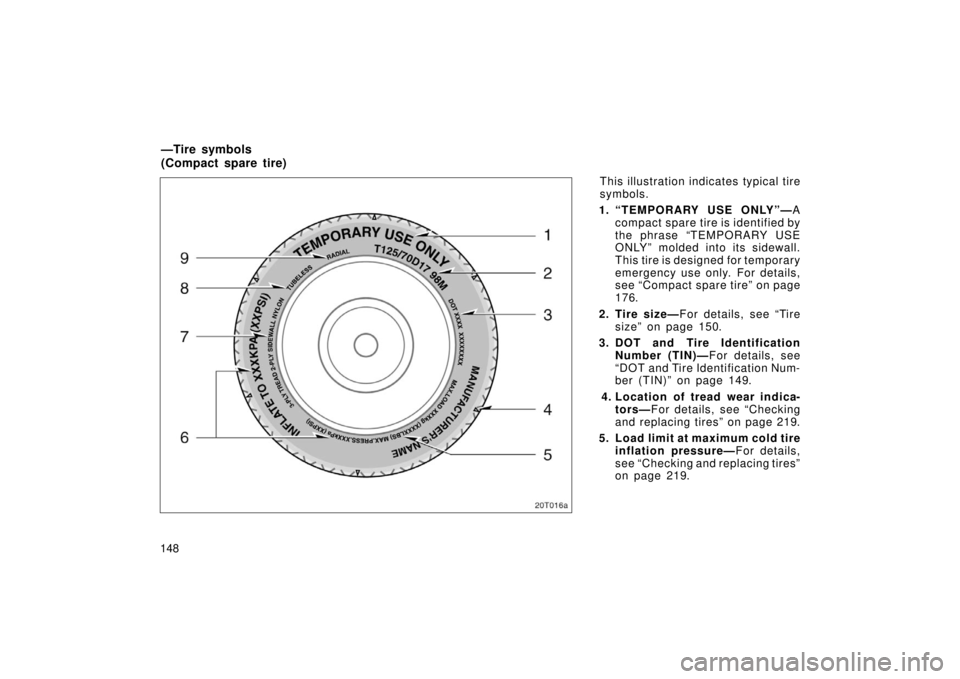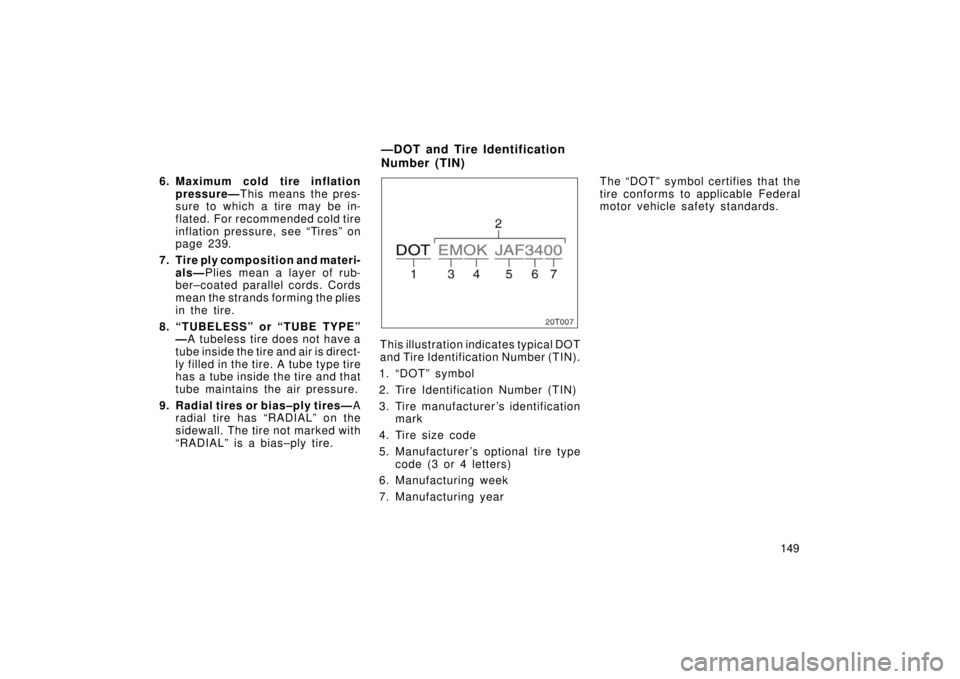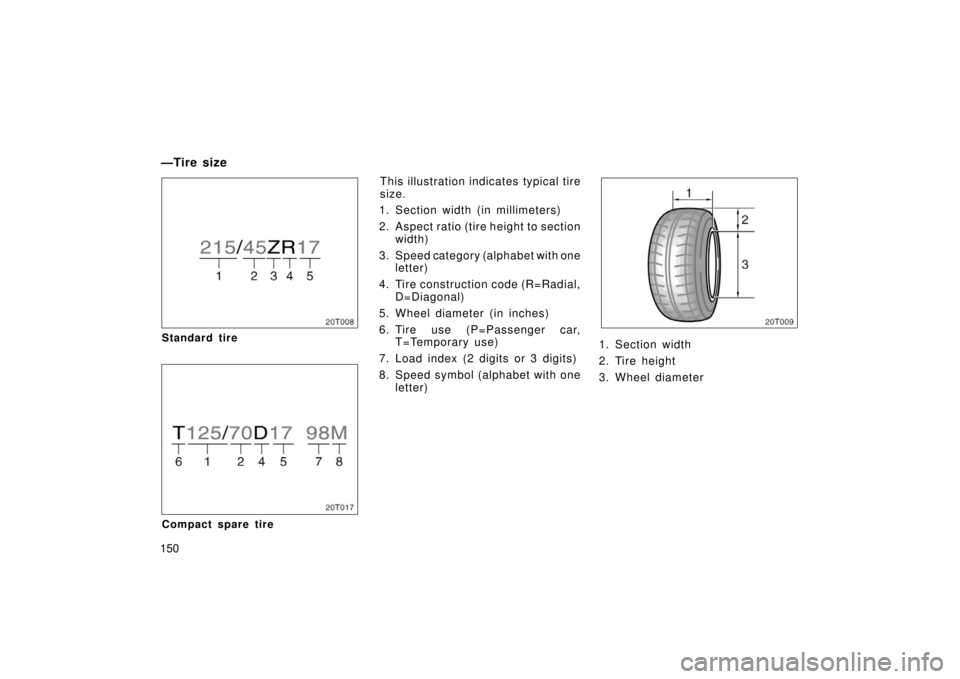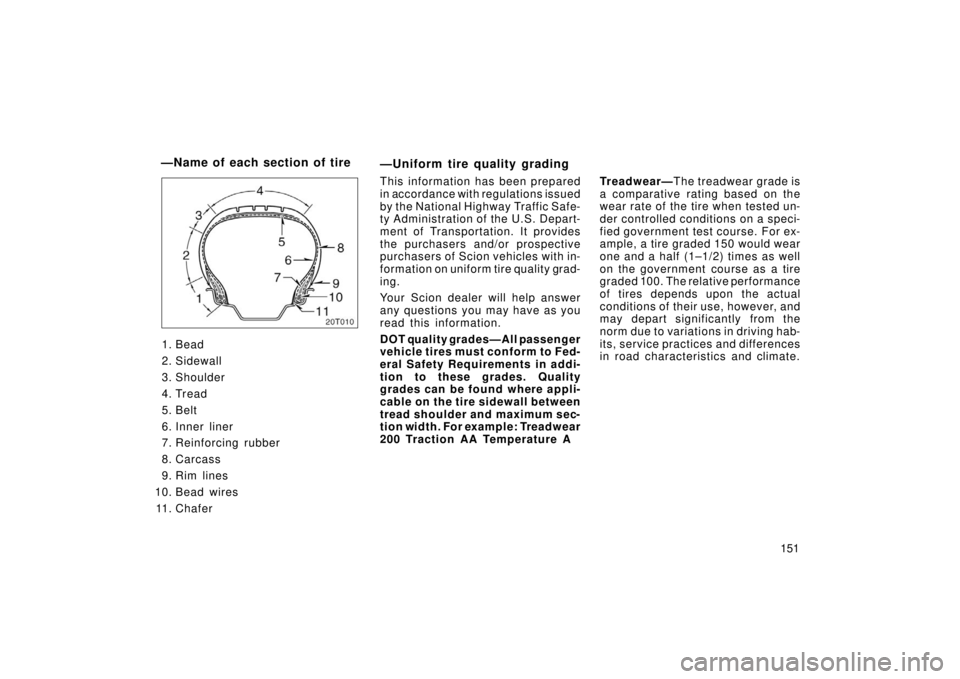TOYOTA tC 2006 Owners Manual (in English)
Manufacturer: TOYOTA, Model Year: 2006, Model line: tC, Model: TOYOTA tC 2006Pages: 256, PDF Size: 4.48 MB
Page 151 of 256

143
CAUTION
If the “ABS” warning light remains on
together with the brake system warn-
ing light, immediately stop your ve-
hicle at a safe place and contact your
Scion dealer.
In this case, not only the anti–lock
brake system will fail but also the
vehicle will become extremely unsta-
ble during braking.
DRUM–IN–DISC TYPE PARKING BRAKE
SYSTEM
Your vehicle has a drum–in–disc type
parking brake system. This type of brake
system needs bedding–down of the brake
shoes periodically or whenever the parking
brake shoes and/or drums are replaced.
Have your Scion dealer perform the bed-
ding–down.
Brake pad wear limit indicators
The brake pad wear limit indicators on
your disc brakes give a warning noise
when the brake pads are worn to where
replacement is required.
If you hear a squealing or scraping noise
while driving, have the brake pads
checked and replaced by your Scion deal-
er as soon as possible. Expensive rotor
damage can result if the pads are not
replaced when necessary.The vehicle identification number (VIN)
is the legal identifier for your vehicle.
This number is on the left top of the
instrument panel, and can be seen
through the windshield from outside.
This is the primary identification number
for your Scion. It is used in registering
the ownership of your vehicle.
Your Scion’s identification—
—Vehicle identification
number
Page 152 of 256

144
The vehicle identification number (VIN) is
also on the Certification Label.
—Engine number
20T006
The engine number is stamped on the
engine block as shown.
Theft prevention labels
Your new vehicle carries theft preven-
tion labels which are approximately 56
mm (2.20 in.) by 16 mm (0.63 in.).
The purpose of these labels is to reduce
the incidence of vehicle thefts by facilitat-
ing the tracing and recovery of parts from
stolen vehicles. The label is designed so
that once it is applied to a surface, any
attempt to remove it will result in destroy-
ing the integrity of the label. Transferring
these labels intact from one part to anoth-
er will be impossible.
NOTICE
You should not attempt to remove the
theft prevention labels as it may vio-
late certain state or federal laws.
Page 153 of 256

145
Suspension and chassis
CAUTION
Do not modify the suspension/chassis
with lift kits, spacers, springs, etc. It
can cause dangerous handling charac-
teristics, resulting in loss of control.
Page 154 of 256

146This illustration indicates typical tire
symbols.
1. Tire size— For details, see “Tire
size” on page 150.
2. DOT and Tire Identification Number (TIN)— For details, see
“DOT and Tire Identification Num-
ber (TIN)” on page 149.
3. Location of tread wear indica- tors— For details, see “Checking
and replacing tires” on page 219.
4. Tire ply composition and materi- als— Plies mean a layer of rub-
ber–coated parallel cords. Cords
mean the strands forming the plies
in the tire.
5. Summer tire or all season tire— An all season tire has “M+S”
on the sidewall. The tire not
marked with “M+S” is a summer
tire. For details, see “Types of
tires” on page 160.
6. Radial tires or bias–ply tires— A
radial tire has “radial” on the side-
wall. A tire not marked with “radial”
is a bias–ply tire.
Tire information—
—Tire symbols (Standard tire)
20T015
Page 155 of 256

147
7. “TUBELESS” or “TUBE TYPE”
—Tubeless tire does not have a
tube inside the tire and air is direct-
ly filled in the tire, avoiding rapid
air leakage even if the tire is nailed
and preventing the tire from burst-
ing with a shock. Tube type tire has
a tube inside the tire and that tube
maintains the air pressure.
8. Load limit at maximum cold tire inflation pressure— For details,
see “Checking and replacing tires”
on page 219.
9. Maximum cold tire inflation pressure— This means the pres-
sure to which a tire may be in-
flated. For recommended cold tire
inflation pressure, see “Tires” on
page 239.
10. Uniform tire quality grading— For details, see “Uniform tire quali-
ty grading” that follows.
Page 156 of 256

148This illustration indicates typical tire
symbols.
1. “TEMPORARY USE ONLY”— A
compact spare tire is identified by
the phrase “TEMPORARY USE
ONLY” molded into its sidewall.
This tire is designed for temporary
emergency use only. For details,
see “Compact spare tire” on page
176.
2. Tire size— For details, see “Tire
size” on page 150.
3. DOT and Tire Identification Number (TIN)— For details, see
“DOT and Tire Identification Num-
ber (TIN)” on page 149.
4. Location of tread wear indica- tors— For details, see “Checking
and replacing tires” on page 219.
5. Load limit at maximum cold tire inflation pressure— For details,
see “Checking and replacing tires”
on page 219.
—Tire symbols
(Compact spare tire)
20T016a
Page 157 of 256

149
6. Maximum cold tire inflation
pressure— This means the pres-
sure to which a tire may be in-
flated. For recommended cold tire
inflation pressure, see “Tires” on
page 239.
7. Tire ply composition and materi- als— Plies mean a layer of rub-
ber–coated parallel cords. Cords
mean the strands forming the plies
in the tire.
8. “TUBELESS” or “TUBE TYPE” —A tubeless tire does not have a
tube inside the tire and air is direct-
ly filled in the tire. A tube type tire
has a tube inside the tire and that
tube maintains the air pressure.
9. Radial tires or bias–ply tires— A
radial tire has “RADIAL” on the
sidewall. The tire not marked with
“RADIAL” is a bias–ply tire.
20T007
This illustration indicates typical DOT
and Tire Identification Number (TIN).
1. “DOT” symbol
2. Tire Identification Number (TIN)
3. Tire manufacturer ’s identification mark
4. Tire size code
5. Manufacturer ’s optional tire type code (3 or 4 letters)
6. Manufacturing week
7. Manufacturing year The “DOT” symbol certifies that the
tire conforms to applicable Federal
motor vehicle safety standards.
—DOT and Tire Identification
Number (TIN)
Page 158 of 256

150
20T008
Standard tire
20T017
Compact spare tire
This illustration indicates typical tire
size.
1. Section width (in millimeters)
2. Aspect ratio (tire height to section width)
3. Speed category (alphabet with one letter)
4. Tire construction code (R=Radial, D=Diagonal)
5. Wheel diameter (in inches)
6. Tire use (P=Passenger car, T=Temporary use)
7. Load index (2 digits or 3 digits)
8. Speed symbol (alphabet with one letter)
20T009
1. Section width
2. Tire height
3. Wheel diameter
—Tire size
Page 159 of 256

151
20T010
1. Bead
2. Sidewall
3. Shoulder
4. Tread
5. Belt
6. Inner liner
7. Reinforcing rubber
8. Carcass
9. Rim lines
10. Bead wires 11. Chafer
—Uniform tire quality grading
This information has been prepared
in accordance with regulations issued
by the National Highway Traffic Safe-
ty Administration of the U.S. Depart-
ment of Transportation. It provides
the purchasers and/or prospective
purchasers of Scion vehicles with in-
formation on uniform tire quality grad-
ing.
Your Scion dealer will help answer
any questions you may have as you
read this information.
DOT quality grades—All passenger
vehicle tires must conform to Fed-
eral Safety Requirements in addi-
tion to these grades. Quality
grades can be found where appli-
cable on the tire sidewall between
tread shoulder and maximum sec-
tion width. For example: Treadwear
200 Traction AA Temperature A Treadwear—
The treadwear grade is
a comparative rating based on the
wear rate of the tire when tested un-
der controlled conditions on a speci-
fied government test course. For ex-
ample, a tire graded 150 would wear
one and a half (1–1/2) times as well
on the government course as a tire
graded 100. The relative performance
of tires depends upon the actual
conditions of their use, however, and
may depart significantly from the
norm due to variations in driving hab-
its, service practices and differences
in road characteristics and climate.
—Name of each section of tire
Page 160 of 256

152 Traction AA, A, B, C—The traction
grades, from highest to lowest, are
AA, A, B, and C, and they represent
the tire’s ability to stop on wet pave-
ment as measured under controlled
conditions on specified government
test surfaces of asphalt and concrete.
A tire marked C may have poor trac-
tion performance.
Warning: The traction grade assigned
to this tire is based on braking
(straight ahead) traction tests and
does not include cornering (turning)
traction. Temperature A, B, C—
T he tem per a-
ture grades are A (the highest), B,
and C, representing the tire’s resis-
tance to the generation of heat and
its ability to dissipate heat when
tested under controlled conditions on
a specified indoor laboratory test
wheel. Sustained high temperature
can cause the material of the tire to
degenerate and reduce tire life, and
excessive temperature can lead to
sudden tire failure. The grade C cor-
responds to a level of performance
which all passenger car tires must
meet under the Federal Motor Vehicle
Safety Standard No. 109. Grades B
and A represent higher levels of per-
formance on the laboratory test wheel
than the minimum required by law.
Warning: The temperature grades for
this tire are established for a tire that
is properly inflated and not over-
loaded. Excessive speed, underinfla-
tion, or excessive loading, either sep-
arately or in combination, can cause
heat buildup and possible tire failure.